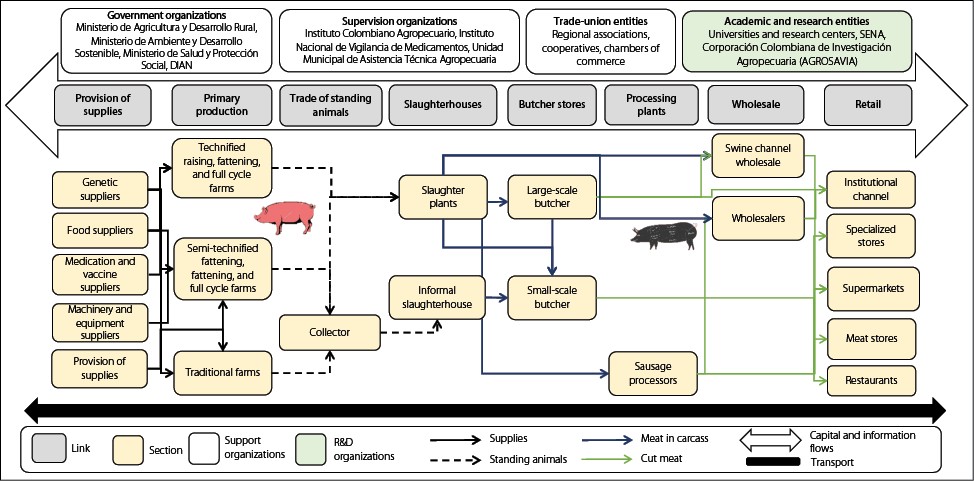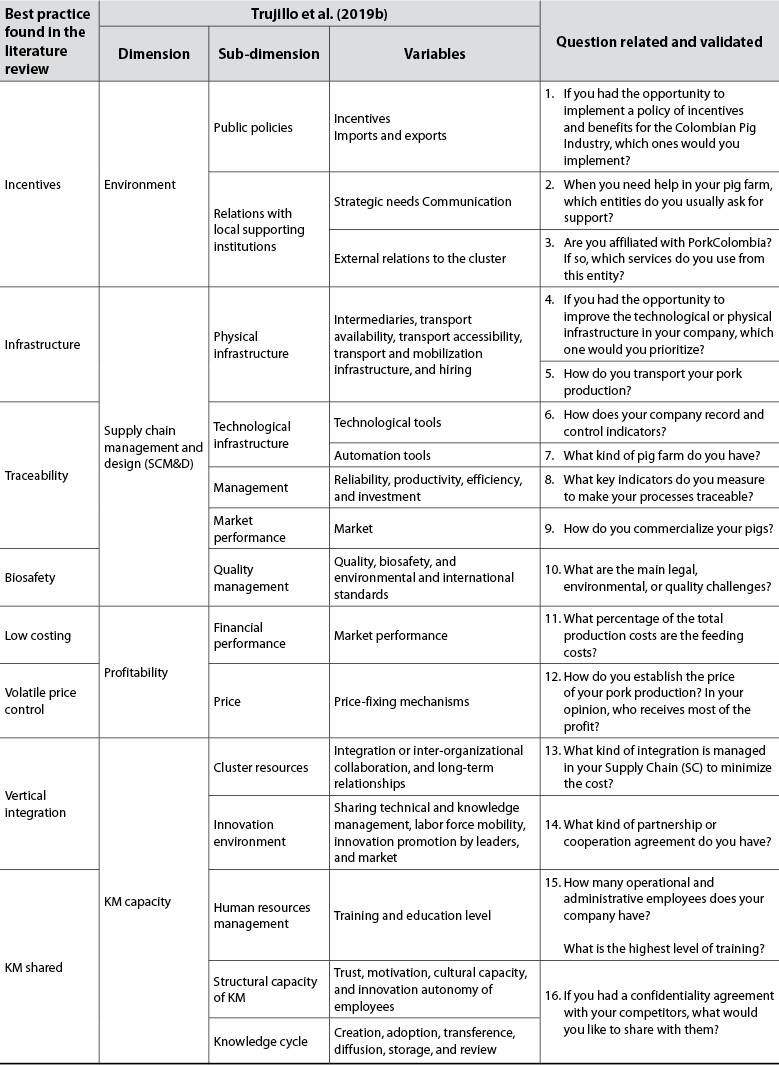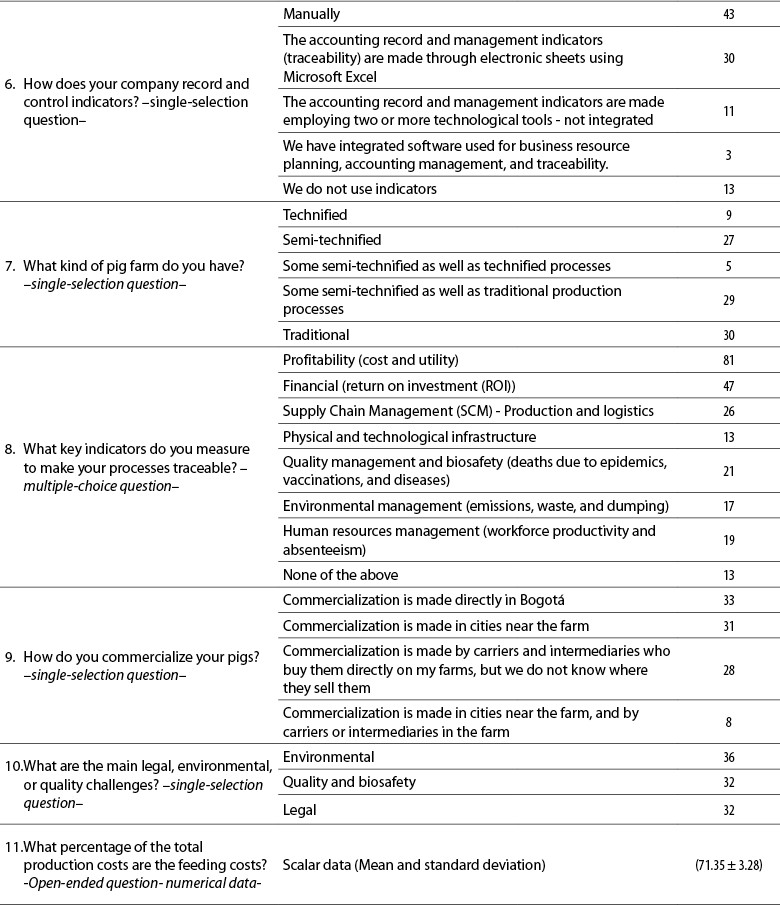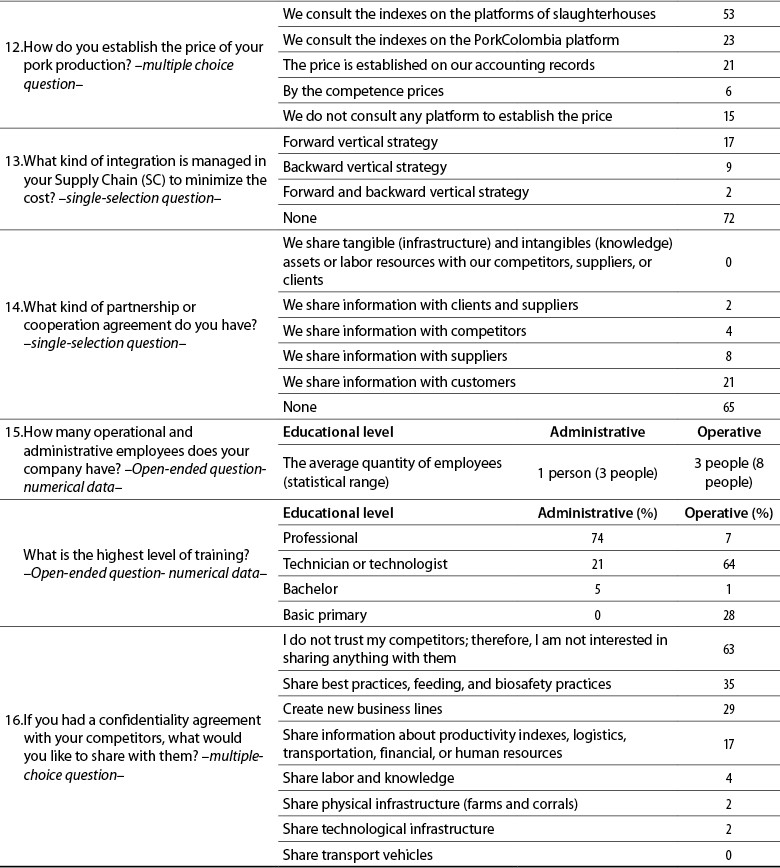Introduction
Pork is the most consumed meat-type worldwide (Agricultural Marketing Resource Center, 2018), with an average consumption of 37.4 %, equivalent to 110 million metric tons (MMT). On the other hand, chicken, bovine, and ovine meat consumption are lower, with 35.3 % (104 MMT), 22.6 % (67 MMT), and 4.7 %, respectively (McGlone, 2013). In addition, Colombian pork consumption has been increasing since 2009, ranging from 4.22 kg/per capita to 9.4 kg/per capita in 2017, according to Federación Colombiana de Ganaderos (2018).
China is the leading pork meat producer, since its production is almost half of the one recorded worldwide, followed by the US (Agricultural Marketing Resource Center, 2018; McGlone, 2013), and Germany (McGlone, 2013). In contrast, Colombia does not have entry barriers for global competitors in the Colombian Swine Industry (CSI) (UN Comtrade, 2017). Therefore, the swine market in Colombia is comprised of importers and technified, semi-technified, and non-technified (small-scale) pork farmers who use traditional production systems (Sociedad de Agricultores de Colombia [SAC], n.d.).
In Colombia, agriculture is considered the second most important economic activity (Departamento Administrativo Nacional de Estadística [DANE], 2016), and it is subdivided into agricultural crops and livestock (DANE, 2013). The Colombian agricultural GDP is 6.5 % (DANE, 2015; SAC, n.d.), and the swine (11 %), bovine (43 %), and poultry (46 %) sectors (DANE, 2013; SAC, n.d.) compose the livestock market.
Colombian swine production aims to supply domestic demand (Trujillo-Diaz et al., 2019a). Since 2008, Colombian pork imports, production, and consumption have been increasing (DANE, 2018b). Although Colombian bovine production grows (4.2 %), swine production grows by more than double (8.8 %) (DANE, 2018a). The main pig producers are located in the departments of Antioquia, Cordoba, Cundinamarca, Meta, and Valle del Cauca (DANE, 2016), with 4.1 million pigs slaughtered in 2017 (representing 711 million USD) (DANE, 2018b). The main importing departments are Bolivar, Cundinamarca, and Valle del Cauca (Sistema Estadístico de Comercio Exterior, n.d.) due to lack of protectionist laws or subsidies to encourage national production (Dunay & Vinkler-Rajcsányi, 2016). Furthermore, the import cost of pork carcass is more competitive than the national sale price. In the same year, Colombia imported roughly 177 million USD of pork meat in cold carcass, mainly due to international trade agreements (UN Comtrade, 2017). Overall, Colombia imported 91.2 % of refrigerated pork from the US, 5.1 % from Canada, 3.7 % from Chile, and 0.1 % from other countries such as Denmark, Portugal, and Spain (DANE, 2018b; UN Comtrade, 2017).
The central problem of the CSI is profitability, since Colombia has one of the highest production costs in Latin America for standing pigs due to feeding costs, representing 73.25 % of the total production costs, followed by labor costs (6.04 %), and finally, installation costs (3.56 %) (Asociación PorkColombia, 2018a). For instance, in 2018, while the average production cost was 1.55/kg USD for standing pigs and 2.09/kg USD for pork meat in cold carcass (Asociación PorkColombia, 2018a), the average price for standing pigs was 1.57/kg USD, 2.07/kg USD for warm carcass, and 2.13/kg USD for cold carcass (Asociación PorkColombia, 2018a).
The CSI is comprised of eight links: 1) provision of supplies, including genetics, food, medication and vaccines, equipment and machinery, and suppliers; 2) primary production, breeding, and fattening farms, and also those classified as technified, semi-technified, or traditional farms; 3) trading and transportation of standing pigs; 4) slaughterhouses; 5) big and small butcher stores; 6) processing plants, 7) wholesale, and 8) retail companies. Furthermore, the CSI is supported by governmental and private (local and national) institutions (Bezkorovainyi & Jarzębowski, 2016; Johnston, 2004; Lazzeretti et al., 2013; Martin & Sunley, 2003; Malmberg & Maskell, 2002; Neven & Droge, 2001; Organization for Economic Cooperation and Development, 1999; Rosenfeld, 1995, 1997; Trujillo-Diaz et al., 2019b). The local regulation of the CSI depends on Ministerio de Agricultura y Desarrollo Rural, and breeding and trading of standing pigs as well as pork meat commercialization, are regulated by Instituto Colombiano Agropecuario (ICA) and Instituto Nacional de Vigilancia de Medicamentos y Alimentos (Invima), respectively (figure 1).
The primary swine production in Colombia is classified into semi-technified, technified, or traditional infrastructure and processes. Moreover, it is sub-classified into a) core farms dedicated to genetic improvement, selling semen sash for insemination, and reproducing sows and boars (males) sold to breeding farms; b) breeding farms that work on the reproduction of sows and boars (males) sold to commercial farms when reaching weights of 75 kg and 120 kg, respectively, and c) commercial farms dedicated to raising piglets for sale, and raising pigs between 100 and 130 kg of weight (Solla, n.d.).
As illustrated in figure 1, slaughter is the fourth link in the CSI. Colombia has policies to control the slaughtering of standing pigs (Ley 89, 1993; Ley 272, 1996), just like China that has implemented its policies for more than 20 years (Chen & Yu, 2018). These policies have important connotations for CSI, including a) slaughterhouses are the only authorized places in Colombia for slaughtering pigs; b) given the expensive infrastructure of slaughterhouses, it is an oligopoly that reduces the possibility to be integrated into the CSI, increasing intermediation; c) some Colombian slaughterhouses establish the reference prices for piglets and standing pigs, and d) a promotion fee is paid per each slaughtered pig, and is set aside for Fondo Nacional de la Porcicultura (Asociación PorkColombia, 2018b).
The CSI is very attractive for farmers, because the pig cycle is around 296 days (figure 2), i.e., shorter than the bovine cycle. However, pork production has different biosafety, traceability (Dunay & Vinkler- Rajcsányi, 2016; Qian et al., 2017), and animal welfare standards (Decreto 2113, 2017; Dias et al., 2015; Martins et al., 2017). Nonetheless, these standards generate limitations for some companies, and give rise to a competitive advantage for businesses.
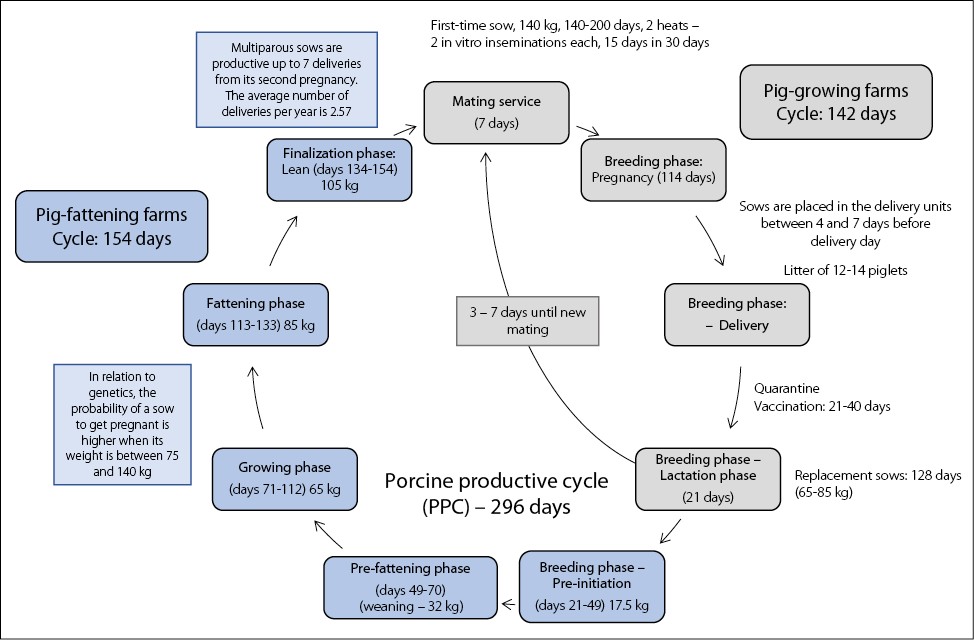
Source: Trujillo-Diaz et al. (2019a)
Figure 2. Porcine production cycle in the Colombian swine industry
Promotion factors for best practices in the Global Swine Industry
The literature review revealed that several factors promote the competitiveness in the Swine Industry at the global level (GSI), including a) loan design, subsidies, and incentive programs for the industry; b) infrastructure, c) cost minimization, d) price speculation, e) traceability, f) biosafety processes, g) vertical integration, h) animal welfare, and i) knowledge management. These global factors are described below:
The first factor is how subsidies, credit programs, tax reductions, incentives, and economic benefits have been created in the GSI by governments, such as Hungary (Dunay & Vinkler- Rajcsányi, 2016) and the US (Dunay & Vinkler-Rajcsányi, 2016), to promote swine production and export.
The second factor includes breeding and fattening infrastructure of farms limited by land availability (Selva, 2005). For instance, some developed countries, such as the US, have big farms with about 100 thousand pigs (Selva, 2005), whereas China (Chen & Yu, 2018) and Spain are characterized by having small farms (Valiño et al., 2019). Conversely, Danish farms are specialized in some breeds with standardized feeding (Bogetoft & Olesen, 2002). As infrastructure also includes transportation, studies carried out in Colombia (Asociación PorkColombia, 2015; Castrillón et al., 2005), China (Fulai, 2007; Yinglin et al., 2014, 2015), and the US (Cunningham, 1998; Da Silva, et al.,1995) have identified that infrastructure failures in swine farms, especially in transportation facilities, affect animal welfare. This, in turn, affects meat quality (Castrillón et al., 2005), increasing illness transfer, and public health problems (Food and Agriculture Organization of the United Nations, 2001).
The third factor is low costing (Selva, 2005). China (Chen & Yu, 2018). The US (Selva, 2005), Spain (Dunay & Vinkler-Rajcsányi, 2016; Selva, 2005), Denmark, Germany, and France, among other countries, have low production costs for high-quality meat (Hoste, 2017; Schramm & Spiller, 2003; Schulze et al., 2007; Selva, 2005), and high-tech processes (Dunay & Vinkler- Rajcsányi, 2016; Selva, 2005). However, the feeding cost is one of the highest items in GSI; for instance, Brazil has high-scale corn and soy farming, which is the primary raw material for producing pig feed (Dias et al., 2015), allowing low prices in the swine industry (SI), but not necessarily with high-quality (Machado et al., 2016; Selva, 2005; Trienekens & Wognum, 2013).
The fourth factor is price volatility (Dunay & Vinkler-Rajcsányi, 2016) and the control of supplies in the slaughterhouse link (Chen & Yu, 2018; Yu, 2015). Countries such as Denmark have price- fixing policies supported by their National Production Committee (Selva, 2005), while other countries, such as Poland and Hungary, have non-fixed (variable) prices (Dunay & Vinkler- Rajcsányi, 2016).
The fifth factor is practices and traceability software that avoids SI losses related to illness, lack of biosafety practices, quality, and productivity (Dias et al., 2011). In addition, it is a powerful strategy in Agribusiness Supply Chain Management (ASCM), since it implies the design of indexes and its control for decision making. For that matter, some traceability systems have been designed by countries, such as China (Qian et al., 2017), the UK, and Brazil (Dunay & Vinkler- Rajcsányi, 2016) to keep disease outbreaks under observation (Dunay & Vinkler-Rajcsányi, 2016; Martins et al., 2017).
The sixth factor is the implementation of biosafety practices, which are the most critical characteristic to guarantee pork quality, as these generate limitations to enter markets, such as China (Chen & Yu, 2018), the UK (Martins et al., 2017), and Denmark; the latter due to costing (Selva, 2005). In fact, some organizations that have established these kinds of regulations are the Food and Agriculture Organization of the United Nations (FAO) (Dias et al., 2011), and the World Trade Organization (WTO) (Martins et al., 2017).
The seventh factor is the backward and forward vertical integration strategies used to increase profitability and minimize costs. This has been carried out in Denmark (Selva, 2005), and Brazil, which have proposed coordination strategies and governance structures, cooperation alliances, and vertical integration; all of the above has been done to increase competitiveness and comply with public quality and biosafety regulations (Martins et al., 2017; Ménard, 2004; Raynaud et al., 2005).
The eighth factor is animal welfare practices, which have been implemented in the UK and Brazil, obtaining better quality and healthier pork meat (Dias et al., 2015; Martins et al., 2017); however, this practice is novel in the GSI.
The ninth factor is knowledge management practices. Knowledge clusters have been created in Germany (Ministerio de Agricultura, Ganadería y Pesca et al., 2013; Vieites, 1997) to share knowledge and best practices in the meat industry (Schramm & Spiller, 2003). On the other hand, China (Qian et al., 2017), the UK, and Brazil (Dunay & Vinkler-Rajcsányi, 2016) carry out training programs and establish cooperation agreements with suppliers to comply with quality, biosafety, and transportation requirements (Dunay & Vinkler-Rajcsányi, 2016; Martins et al., 2017). Finally, Brazil has designed manuals for good agricultural practices and biosafety, technical management for vehicles, and traceability software used as a knowledge capitalization tool (Dunay & Vinkler-Rajcsányi, 2016; Martins et al., 2017).
Competitiveness studies in the swine industry
Competitiveness has been addressed from qualitative theories and quantitative indexes (Moon & Cho, 2000). In the first place, in the literature review, a qualitative competitiveness analysis of the SI was carried out in Denmark applying the five forces of Porter's Diamond Model and a SWOT analysis (strengths, weaknesses, opportunities, and threats) (Selva, 2005). Second, ten quantitative studies focused on agribusiness agglomerations as collaboration networks, supply chains (SC), clusters, or industrial parks (Gaviria-Marín et al., 2017) were found. Third, five specific studies on SI competitiveness applications, with examples of the swine clusters in Daireaux and Henderson (Argentina) (Ministerio de Agricultura, Ganadería y Pesca et al., 2013), in Sonora, Mexico (González et al., 2012), in the Republic of Buryatia, Russia (Dorzhieva & Dugina, 2015), in Poland (Bronisz & Heijman, 2008), and in Canada (Li, 2018) were included.
Fourth, a couple of quantitative competitiveness and profitability studies in the SI have been identified in the literature review. For instance, a profitability estimation in the SI was carried out by the Agriculture and Horticulture Development Board (AHDB, 2011) in the UK. Institut du porc Recherche et Expertise pour la Filière Porcine (IFIP) developed a SI competitiveness index applied in the European Union (EU) (Duflot et al., 2014). However, these indexes were consolidated by Trujillo-Diaz et al. (2019b) to measure profitability and knowledge management.
Specific studies applied in the competitiveness of SI carried out in Colombia were found in the literature; nevertheless, all of them are bachelor degree thesis works, not yet published, and include: "The competitiveness of the pig meat production chain in Colombia between 2007 and 2010" (Cárdenas, 2012), "Characterization of the marketing link of the pork meat chain in Villavicencio - Meta" (Gómez, 2017), “Analysis of the marketing link of the pork meat chain in Fomeque, Cundinamarca” (Pérez, 2017), and “Analysis of pork imports and its by-products in the Colombian pork market: a perspective under Free Trade Agreements (FTA)” (Velásquez et al., 2013).
The thesis work by Cárdenas (2012), carried out an investigation in Colombia between 2007 and 2011; a SWOT matrix was built supported by surveys to SI experts using qualitative theories of competitiveness, concluding that infrastructure is insufficient and that imports have been increasing compared to national production figures. In the commercialization link, Gómez (2017) and Pérez (2017), using the CADIAC method, characterized the commercialization link in an international context to establish a solid background for a national study. These works concluded that the commercialization link has low association levels, and meat processing plants were identified as the main sale channel. Velásquez et al. (2013) concluded that economic openness in Colombia has been decreasing since the Free Trade Agreement came into force, affecting the porcine sector.
Accordingly, this study aims to identify the nine best global swine practices from the literature review carried out, and contrast their applicability level in swine in the Central Andean Region of Colombia (CARC), through the design, application, and validation of a measurement instrument. This work was performed to answer the following research question: What kind of GSI practices are applied in fattening and breeding pig farms in the CARC?
Materials and methods
This study is exploratory and descriptive. The representative sampling was selected using a probabilistic method from a population of pig breeding and feeding companies located in the CARC, for which a measurement instrument was designed using the literature review (see the Measurement instrument design section). Subsequently, it was validated by experts, and the results are shown in table 2.
In Colombia, there are 830 pig farming enterprises (figure 3). The population data was bought from the Chamber of Commerce of Bogota on April 12, 2019, including the Colombian swine companies currently affiliated and active. This database included 229 Colombian pig farms dedicated to breeding and fattening; these enterprises are located in the departments of Cundinamarca (192), Boyacá (18), Tolima (10), and Huila (9). This area was selected since the Colombian population is concentrated in the Andean region and on the Atlantic coast. Bogotá is the capital city where the departments selected in this research sell their live pigs. Cundinamarca is the first Colombian live pig producer department, representing 23 % of the total production in the country, while Boyacá has 2.2 %, Tolima 1.2 %, and Huila 1.1 % (figure 3).
The sample size to survey randomly was 50 pig production companies according to the probabilistic sampling; however, the response rate was 104 % because 53 pig farms were finally surveyed. The experts who validated the instrument were excluded from the sampling. Therefore, the sampling applied was for a finite population under the probability assumption of an event happening or not, for which the probability handled was 0.5. The confidence level was 95 % using the Z statistic of 1.645, and the accepted maximum estimation error was 0.1 (Hernández Sampieri et al., 2014).
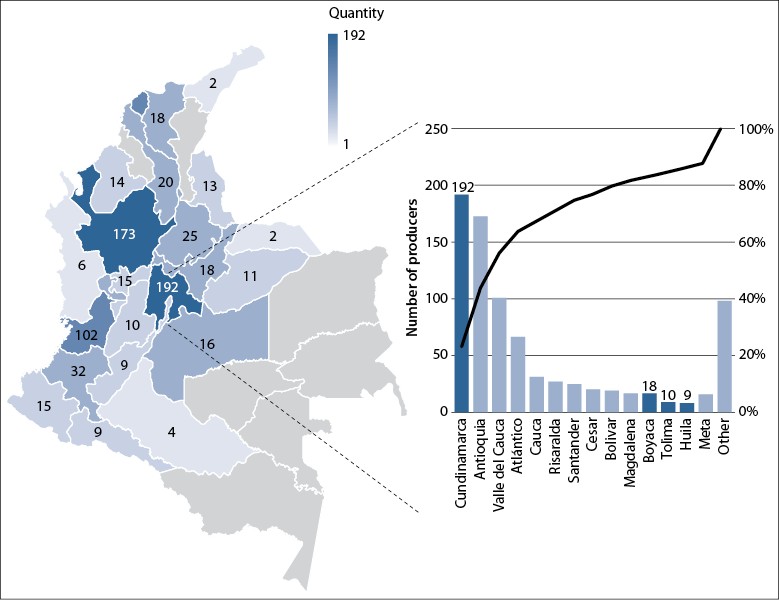
Source: Elaborated by the authors
Figure 3. Colombian pig companies registered on the Chamber of Commerce of Bogota webpage on April 12, 2019.
Measurement instrument design
The SI competitiveness has been measured through profitability, management, and infrastructure indexes (AHDB, 2011; Duflot et al., 2014; Trujillo-Diaz et al., 2019a). Nevertheless, SI competitiveness and knowledge management (KM) should be measured considering multidimensional variables and dimensions (Trujillo-Diaz et al., 2019b). This is because knowledge management (KM) contributes to improving the organizations and agglomerations performance, adds value and innovation capacity, and increases the competitive advantage (Peng Wong & Yew Wong, 2011) under uncertainty environments (Kant & Singh, 2008; Martínez, et al., 2013). Indeed, the competitive advantage in those kinds of models is boosted with training programs in organizations, supply chains, and agglomerations, the interaction of stakeholders using technologies to access information and collaboration agreements, and best transference practices (Hoffmann et al., 2014). Therefore, a stakeholder involved in a knowledge model has the responsibility to motivate organizational and inter-organizational economic development to create trust, culture, and knowledge capitalization (Kant & Singh, 2008).
With the above, the measurement instrument proposed was designed using the dimensions, sub- dimensions, and variables for measuring SI competitiveness and KM found in the literature review (Trujillo-Diaz et al., 2019b). This instrument was designed for measuring the best practices of the SI that have been applied in the Colombian Central Andean Region (CARC) comprised of the following departments: Cundinamarca, Boyacá, Huila, and Tolima. Additionally, it included 16 categorical and quantitative questions summarized in table 1, after its validation by seven experts. However, experts who validated the measurement instrument designed were excluded from the probabilistic sample.
Results and discussion
The results shown in this article correspond to 27.6 % of the Colombian pig production. Cundinamarca is the first Colombian live pig producer department, representing 23 % of the total country production, while Boyacá has 2.2 %, Tolima 1.2 %, and Huila 1.1 %. Additionally, the swine market in Colombia is comprised of importers and technified, semi-technified, and non-technified (small-scale) pork farmers who use traditional production systems (SAC, n.d.). While a traditional pig farm has around 50 sows, a semi-technified pig farm has 100 sows, and a technified pig farm has more than 150 sows. The most common breeds in the CARC under study are Yorkshire (23 %), Pietrain (21 %), Duroc (19 %), Landrace (17 %), Landrace-Belgian (11 %), and Hampshire (9 %). After the application of the measurement instrument, the probabilistic sampling results were summarized in table 2.
Table 2. Summarized results of the survey to know the level of applicability of the best global swine practices used in the Central Andean region of Colombian. This survey aimed to contrast the nine best global swine practices found in the literature review.

Source: Elaborated by the authors
Discussion
Global competitors such as China (Chen & Yu, 2018), the US (Dunay & Vinkler-Rajcsányi, 2016; Selva, 2005), Spain (Dunay & Vinkler-Rajcsányi, 2016; Selva, 2005), and Hungary (Dunay & Vinkler-Rajcsányi, 2016), have created incentives and benefits to boost swine production. In contrast, to lower costs (Selva, 2005), Denmark, Germany, France (Hoste, 2017; Schramm & Spiller, 2003; Schulze et al., 2007; Selva, 2005), and Brazil, have encouraged corn and soya farming for fodder production (Dias et al., 2015). Consequently, the first challenge for the CARC is the creation of pork feeding subsidies and policies for tax reduction, because the results of this study show that feeding costs are around 60-80 % of the total production costs. In the same way, Asociación PorkColombia (2018a) indicates that feeding costs are around 73.25 %, followed by workforce or labor costs (6.04 %), and infrastructure (3.56 %). Additionally, to control the feeding costs, competitive countries such as the US (Selva, 2005), China (Chen & Yu, 2018), Spain (Valiño et al., 2019), and Denmark (Selva, 2005), have standardized their pig feeding using automatic pig waterers and feeders (Bogetoft & Olesen, 2002).
If the production costs were lower, the price could be less variable (Dunay & Vinkler-Rajcsányi, 2016). Therefore, as in Denmark, price-fixing policies make the competitiveness environment decrease (Selva, 2005). In contrast, Poland and Hungary have high variability in prices (Dunay & Vinkler-Rajcsányi, 2016), generating an increase in competitiveness. Pig farmers in the CARC establish their sale prices based on information from the website and indexes of PorkColombia on the Colombian slaughterhouse platforms, where the government has centralized the Colombian pig slaughter, just as has been done in China. As a matter of fact, China has implemented it by issuing a limited number of pig-slaughtered licenses, and its respective reporting (Chen & Yu, 2018). Similarly, the CSI (Ley 89, 1993; Ley 272, 1996) has been paying a promotion-fee for Fondo Nacional de la Porcicultura [National Pig-farming Fund] per sacrificed pig. This fee is collected by PorkColombia, and is around 2.7 USD per sacrificed pig to increase competitiveness (Asociación PorkColombia, 2018b). Based on the information from this survey, most pig farmers do not use the services of PorkColombia.
To increase profitability and competitiveness, minimize costs, and comply with public quality standards and biosafety regulations, the CSI companies have generated backward and forward vertical integration strategies, such as has been done in Denmark (Selva, 2005), or Brazil where governance structures have been proposed (Martins et al., 2017; Ménard, 2004; Raynaud et al., 2005). However, many pig farmers of the CARC do not trust their competitors to sign cooperation agreements or vertical integration strategies, but instead, they are interested in creating new business lines, and sharing best feeding and biosafety practices.
The following challenge in the CSI is technology and software creation (Dunay & Vinkler-Rajcsányi, 2016; Selva, 2005), because, in this study, the traceability of the pig farmers in CARC, and the registration of profitability, cost, or productivity indexes are done manually. However, the pork producers under study indicated that they are more interested in farm automation than in software design. Some traceability systems have been designed by several countries, such as China (Qian et al., 2017), the UK, and Brazil (Dunay & Vinkler-Rajcsányi, 2016), to keep under observation disease outbreaks (Dunay & Vinkler-Rajcsányi, 2016; Martins et al., 2017), and control some indexes as the profitability index (Trujillo-Diaz et al., 2019b). However, as shown in this study, more types of indexes should be measured in the SI of CARC using technological infrastructure and software, but pig farmers are much more interested in cost reduction than in traceability. Some indexes that SI should measure are financial performance, productivity, environmental management, quality management, and biosafety (Trujillo-Diaz et al., 2019b).
Studies carried out in Colombia (Asociación PorkColombia, 2015; Castrillón et al., 2005), China (Fulai, 2007; Yinglin et al., 2014, 2015), and in the US (Cunningham, 1998; Da Silva et al., 1995) indicate that physical infrastructure includes transportation of goods. In the CARC results, two central transportation modalities are used to deliver pigs that come from pig farmers located in the city suburbs, in Bogotá. These modalities are direct-contract transportation, and pig farm consolidation in the same trucks. In this way, countries like Argentina have tried to eliminate the intermediation to slaughterhouses (Ministerio de Agricultura, Ganadería y Pesca et al., 2013; Vieites, 1997), because these practices affect animal welfare, meat quality (Castrillón et al., 2005; Dias et al., 2011; (Food and Agriculture Organization of the United Nations, 2001), and reduces profits. As shown in this study, CARC intermediaries are the ones who receive most of the profit from pig sales.
Knowledge management models have the following cycle: creation, adoption (Kant & Singh, 2008; Lai et al., 2014; Martínez et al., 2013; Peng Wong & Yew Wong, 2011), transference and dissemination (Kant & Singh, 2008; Lai et al., 2014; Martínez et al., 2013; Peng Wong & Yew Wong, 2011), storage (Lai et al., 2014; Martínez et al., 2013), protection (Peng Wong & Yew Wong, 2011), and review (Kant & Singh, 2008). Therefore, in Germany, clusters and associations have been created (Ministerio de Agricultura, Ganadería y Pesca et al., 2013; Vieites, 1997) to share knowledge and best practices in the meat industry (Schramm & Spiller, 2003). Additionally, China (Qian et al., 2017) and the UK (Dunay & Vinkler-Rajcsányi, 2016) have carried out training programs, and have also established cooperation agreements with SI actors to comply with transportation, quality, and biosafety regulations (Dunay & Vinkler-Rajcsányi, 2016; Martins et al., 2017). In the same way, Brazil promotes manuals on agricultural practices for training and knowledge capitalization, focused on the use of best practices, biosafety, technical management of vehicles, and software (Dunay & Vinkler-Rajcsányi, 2016; Martins et al., 2017). On the contrary, this study shows how the SI in the CARC has not implemented knowledge management strategies to share information, indexes, or best practices, due to lack of interest of stakeholders, training programs, and the educational level of labor, causing that more pig farms remain under traditional and semi-technified, non-automated production systems.
Overall, the SI located in CARC has some challenges. The first one is the environmental standards compliance, overly critical, as it could increase costs (Selva, 2005), and generate limitations as well as a competitive advantage (Dias et al., 2011; Martins et al., 2017), just as has been done by China (Chen & Yu, 2018), the UK (Martins et al., 2017), and Denmark (Selva, 2005). The second one is animal welfare rules established in some countries such as the UK and Brazil (Dias et al., 2015; Martins et al., 2017) to guarantee quality pork meat, biosafety, and efficiency in the porcine cycle. However, animal welfare rules have not been implemented in Colombia. The third one is the legal regulation compliance, because swine farms do not seek advice from private or public companies that offer free consultations for the Colombian swine industry in education, innovation programs, or control of diseases, plagues, and vaccinations.
Conclusions
The SI in the CARC needs to create policies in pig farming for breeding and feeding processes. Other protectionist policies are necessary for the SI to avoid many pork imports from the US, due to free trade agreements.
The SI traceability is necessary to control breeding and feeding, biosecurity, and quality; thus, it could be measured through a multidimensional procedure. Nevertheless, Colombian pig farms control their productive systems using only profitability and productivity indexes. Indeed, they need to program traceability software and platforms to manage and make decisions about those processes. Moreover, they need to enlarge and automatize their pig farms, which means a plethora of money and government incentives, because it overcomes the pig feeding cost.
A lack of interest in sharing knowledge is noticeable; pig farmers in the CARC avoid knowledge transfer regarding indexes and best practices, and signing cooperation and integration agreements because they do not trust the competence. Nevertheless, they are interested in the creation of new business lines.











 text in
text in 


